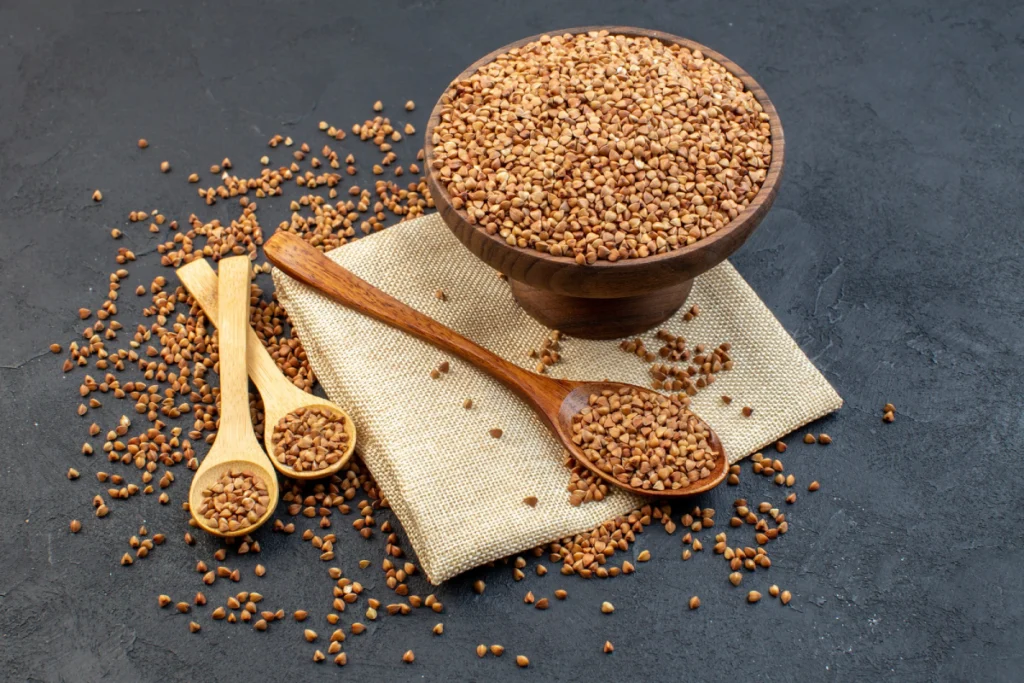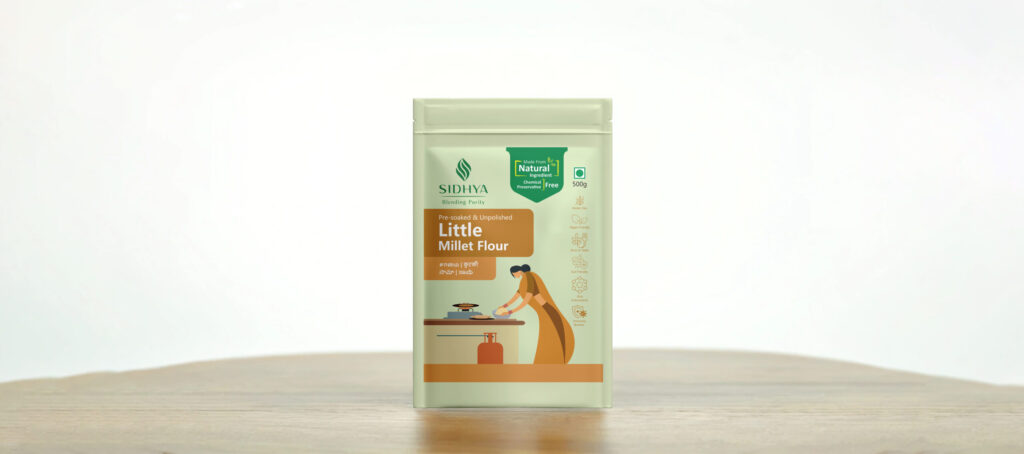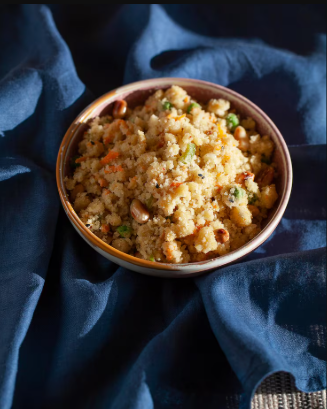Vrat Ke Anaj: 5 Best Millets for Navratri & Fasting in India

During Navratri fasting and food rituals, selecting the right vrat ke anaj (fasting grains) is crucial for maintaining energy, practising satvik eating, and promoting overall health.
In 2025, devotees seek healthy grains for fasting that are easy to digest, nutritious, and in line with tradition. This article explores why millets are opted for, types, benefits, and tips for simple recipes during vrat.
Table of Contents
Why Millets Are Preferred During Fasting?
When it comes to fasting, millets hold a significant place in Indian diets for various reasons: spiritual, nutritional, and practical.
Spiritual / Sattvic Aspect
~ In many Hindu traditions, fasting foods are sattvic, meaning they are pure, light, and cleansing.
~ Millets perfectly embody this philosophy with their unprocessed and wholesome nature. Observed as simple blessings that support spiritual growth and health.
Nutritional Benefits
~ Millets are not only gluten-free but also serve as a fantastic aligner with fasting traditions. They boast a low glycemic index, which helps maintain steady blood sugar levels, crucial for maintaining energy during fasting.
~ With high fibre content and resistant starch, they encourage better digestion and a feeling of fullness, making them ideal for any fasting diet.
~ Additionally, millets are rich in iron, magnesium, B vitamins, and antioxidants, providing a hearty boost to our overall health!
🧪 Regular millet intake has been shown to lower blood sugar levels (FBS by 11.8% and PPBS by 15.1%) while also helping reduce hunger compared to refined grains.1,2
Practical Reasoning
~ Millets cook quickly, are lightweight to carry, and have a longer shelf life, making them ideal for fasting days.
~ While they do contain anti-nutritional factors, such as phytates, simple methods like soaking, sprouting, or fermentation will reduce those properties.
~ With the growing demand for millet-based products, their availability and acceptance are steadily increasing.
Fasting Grains (Vrat ke Anaj): Traditional Choices & Significance
Below are common millet choices used during vrat, with their benefits and use cases:
Barnyard Millet (Samak Rice)
~ Called sanwa or samak, commonly used in place of rice during fasting.
~ Often used in samak pulao or khichdi.
~ Plus, its samak is light and Gentler on digestion, making it a go-to for many during Navratri.
Kodo Millet
~ Known locally as kodon, this millet offers a good source of protein, fibre, and micronutrients.
~ Although less used during fasting, it can certainly shine through when soaked and cooked right.
Little Millet
~ Locally known as wari or kutki, this fine-textured millet cooks rapidly and is best for porridges, khichdi, or as a rice substitute in vrat meals.
~ Its low glycemic index makes it ideal for maintaining energy throughout the fast.
Check out Pink Tiger Verified Sidhya Little Millet Flour

Amaranth / Rajgira
~ Though technically a pseudo-grain, rajgira is a favourite in vrat diets.
~ High in protein, iron, and magnesium.
~ Used in ladoos, poori, patties, or porridges.
Buckwheat / Kuttu
~ Known as kuttu, it is widely accepted during vrat.
~ Rich in flavonoids, fibre, and essential amino acids.
~ Kuttu atta is commonly used to make rotis, chillas, or kuttu ki puri.
~ Because it is gluten-free and has a relatively low glycemic impact, it is well-suited for fasting diets.
The Deeper Why – Fasting Foods and the Body
Why prefer millets over rice or regular wheat during fasting?
Best Grains to Eat During Navratri
Among millets, choices that are easier to digest, gentle on the gut, and nutritionally dense rank higher. Samak, Rajgira, and Kuttu are top picks.
Millets vs Rice for Fasting
Compared to polished white rice, millets offer more fibre, micronutrients, and a lower glycemic response.
🧪 Epidemiological and clinical research has linked millet consumption with lower risks of diabetes, heart disease, and metabolic syndrome.4
High-Protein Fasting Grains
Rajgira (amaranth) stands out for its protein content among Vrat ke anaj options. Buckwheat also contributes decent protein and healthy fats compared to many grains.
How to Cook Millets for Fasting?
Vrat Khichdi (with Samak / Barnyard Millet)

~ Soak ½ cup samak / barnyard millet for 10-15 minutes.
~ In a pot, heat ghee, add cumin, rock salt, green chilli, and ginger.
~ Add soaked millet + water (1:2 ratio), veggies (optional), and cook until soft.
~ Finish with chopped coriander and a squeeze of lemon.
Tips for Cooking Other Millets
~ Soak millets for 15-30 minutes to reduce cooking time and degrade antinutrients.
~ Use a 1:2 ratio of millet to water (or adjust depending on the millet).
~ Use simple seasonings like ghee, cumin, rock salt, and mild herbs.
~ You can make upma, porridge, or sweet kheer versions with milk or jaggery.
~ For rajgira or kuttu flours: make pancakes, puris, ladoos, balls, or patties using minimal ingredients.
Navratri Special Simple Millet Recipes
~ Rajgira puris
~ Kuthu or rajgira cheelas/pancakes
~ Millet ladoos (e.g. rajgira + sesame seeds + jaggery)
~ Sweet porridge made with millets, milk, and jaggery
These preparations keep recipes simple, sattvic, and digestion-friendly.
Conclusion
As you prepare your Navratri diet plan with millets this season, remember that vrat millets, including samak, rajgira, kuttu, and little millet, offer a sweet balance of tradition and nutrition.
These best millets for fasting in India supply stable energy, gentle digestion, and metabolic health (even for diabetics) when used mindfully. With simple recipes, vrat khichdi, puris, and ladoos, you can enjoy Navratri fasting food that is both devotional and healthy.
Don’t forget to follow us on Instagram @pinktiger_by_luke_coutinho for more updates.
Frequently Asked Questions (FAQs)
1. Is millet allowed in Navratri fast?
Yes, many traditions accept samak, kodo, little millet, along with rajgira and kuttu, as valid vrat ke anaj.
2. Which grains are gluten free for fasting?
Samak (barnyard millet), kodo millet, little millet, amaranth (rajgira), and buckwheat (kuttu) are all naturally gluten-free.
3. Can diabetics eat millets during fasting?
Yes, millets improve glucose control. In fact, a meta-analysis found millets reduce fasting and post-prandial glucose compared to staples. However, portion control and monitoring are essential.
4. Which is healthier: kuttu or rajgira?
Both are nutritious and gluten-free. Rajgira (amaranth) has a slightly richer protein profile and micronutrient content; kuttu (buckwheat) brings strong antioxidant compounds. Using both in rotation is a balanced approach.
5. What are the best grains for weight loss fasting?
Low-GI, high-protein, high-fiber grains like barnyard millet, kodo millet, rajgira, and buckwheat are excellent, since they keep you fuller and support better metabolic control.
Disclaimer : This content is for informational purposes only and is not a substitute for professional medical advice, diagnosis, or treatment. Always consult a qualified healthcare provider for any questions or concerns regarding your health.
References :
1. Anitha, S., Tsusaka, T. W., Botha, R., Givens, D. I., Rajendran, A., Parasannanavar, D. J., Subramaniam, K., Bhandari, R. K., & Kane-Potaka, J. (2024). Impact of regular consumption of millets on fasting and post-prandial blood glucose level: a systematic review and meta-analysis. Frontiers in Sustainable Food Systems, 7. https://doi.org/10.3389/fsufs.2023.1226474
2. Anitha, S., Upadhyay, S., & Kane-Potaka, J. (2024). Millets have the potential to increase satiety and reduce the feeling of hunger: a systematic review. Frontiers in Sustainable Food Systems, 8. https://doi.org/10.3389/fsufs.2024.1348068
3. Badal, Robin; Saroch, Arushi; Rai, Ankita1; Singh, Rohit; Yadav, Pramod; Harti, Shivakumar2; Prajapati, Pradeep Kumar3. Millets as Future Grains: Need of Judicious Approach. Journal of Ayurveda 18(4):p 293-303, Oct–Dec 2024. | DOI: 10.4103/joa.joa_80_24
4. Jacob, J., Krishnan, V., Antony, C., Bhavyasri, M., Aruna, C., Mishra, K., Nepolean, T., Satyavathi, C. T., & Visarada, K. B. R. S. (2024b). The nutrition and therapeutic potential of millets: an updated narrative review. Frontiers in Nutrition, 11. https://doi.org/10.3389/fnut.2024.1346869